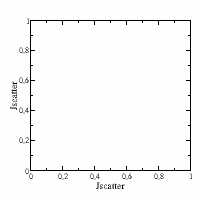Extending/Contributing/Fortran¶
- There are different ways to extend Jscatter by new models.
Write a python function (see Beginners Guide).
Write a Fortran function (preferred >f90) with a wrapper that contains the documentation.
Use Cython or numba …. (for experts, not the scope here).
The simplest way is writing a python function as most functions are written like that. The function should contain the basic model without background or other trivial contributions needed for fitting of real data. These should be added in user defined functions as the user may be better know how he wants to treat the background.
Contribution of a single function or a complete module dealing with a new topic are welcome. As Users should know what it is about, the documentation is important and should contain a scientific reference about the models.
Contributors accept that all new modules or functions included will be covered by the GPLv3 or later.
If modules or code from other projects under OpenSource are used the respective License and Copyright should be mentioned and respected in the source code. Please give important contributions also in the documentation.
Using Fortran
Premature optimization is the root of all evil – DonaldKnuth
The speedup to use more sophisticated methods is not too big (not x100) if the numpy and scipy functions were used.
Here an example with a factor of about 6:
The main part of the cloudScattering function is evaluation of
For e.g. N=20000 . We calc \(S(Q)=F(q) \cdot F^*(q) = |F(q)|^2\) and pass \(F(q)\) for calculation of \(S(q) = < |F(q)|^2 >\) and \(beta =|< F(q) >|^2 / < |F(q)|^2 >\) for spherical averaging.
def _scattering(point,r,q,blength,formfactor):
fa=blength*np.interp(q, formfactor[0, :], formfactor[1, :])
qx=q*point
iqr=np.einsum('i,ji',qx,r)*1j
beiqrsum=np.einsum('i,i',fa,np.exp(iqr))
Sq=beiqrsum*beiqrsum.conj()
return q,Sq.real,beiqrsum.real
The main work is done in np.einsum and np.exp(iqr) which both are already compiled C functions (standard numpy function). We may loose time in coming back to python between these steps.
We can reach a speedup of a factor of 6 if we use a Fortran function and use this in _scattering. The speedup is higher if the computation was done in Python loops (very inefficient), but we use numpy not to do this in Python loops. The speedup depends strongly on the model and how it is implemented. Often one is happy if the python meanders.
The Fortran function/subroutine should be encapsulated in a module as it looks cleaner and the module may contain several functions. Additional it works smoothest in combination with f2py to use a module of functions only (always give intent(in) properly for smooth working). To avoid conflicts and dependency problems it is convenient to copy all needed routines into this module. Please respect Copyrights
module cloud
implicit none
use typesandconstants
use utils
contains
function ffq(point,r,q,blength,formfactor) result(ff)
! point point on unit sphere 3 x 1
real(dp), intent(in) :: point(:)
real(dp) :: ff(3)
.....see fortran/cloud.f95 for all declarations
fa=blength*interpolatesorted(sizerms*q, formfactor(1,:), formfactor(2,:))
qx=q*point
iqr= j1 * matmul( r,qx)
Fq= sum( fa* exp(iqr) )
ff(1)=q
ff(2)=real(Fq*conjg( Fq ) )
ff(3)=real(Fq)
end function ffq
end module
A function interface and the compilation is done by f2py resulting in a shared object file here fsca.so:
f2py -c filename.f95 -m fsca
The module can be imported and used like any other function in a module:
import fsca
def scattering_f(point,r,q,blength,formfactor):
""" A doc is needed if it should be used
Parameters...
Returns.....
"""
ret=fsca.cloud.ffq(point,r,q,blength,formfactor)
return ret
The wrapper is also needed if this function should be called by parallel (using multiprocessing). The reason is that the parallel processed function needs to be serialized and f2py functions cannot. The wrapper can.
If multiprocessing is desired and each process needs to get large arrays the python multiprocessing uses a lot of memory (without shared memory each process gets a pickled copy) In this case Fortran with OpenMP is easier for multiprocessing with shared memory.
Parallel execution with Fortran using OpenMP is used in cloudScattering. Different compiler options for OpenMP with other compilers may lead to failure. The speedup is not very big. In a similar example as above (with individual atomic formfactors) its about 1.5 speedup on 6 core Ryzen for a very complex function. In that specific case the reduced memory was worth it.
Including in Jscatter clone
For contributing or your own development you need to clone the Jscatter repository (See gitlab for documentation.)
git clone https://gitlab.com/biehl/jscatter.git
To use the Jscatter clone do in the main clone directory (dont forget the last point “.” )
pip install --user -e .
The install procedure compiles and builds the wrapper for all source files in the source folder. Additional a link to the clone is placed in your python site-packages folder.
To include a new function in Jscatter package we only need to place the working Fortran module in the source folder and repeat the above command. The setup procedure ads the new function to the fscatter module The function is accessible in a Jscatter module after import of fscatter.
from . import fscatter
data=fscatter.cloud.ffq(q,..... )
The module can be imported were needed and the python wrapper with documentation can be placed in the appropriate module where it is used.
If you are happy and want to contribute, sent it to the author or use a merge request on gitlab.
